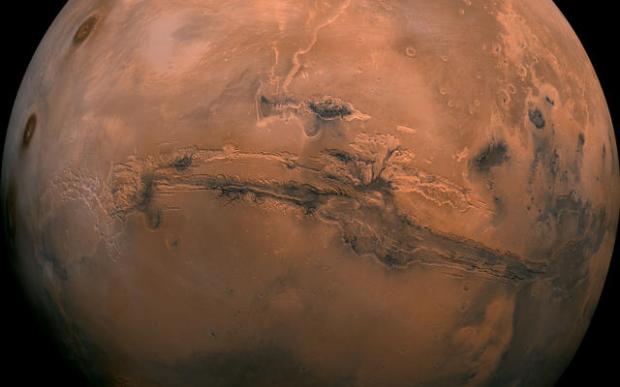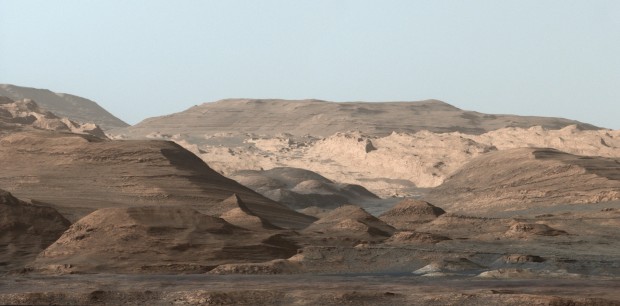
Mars Source: http://mars.nasa.gov/multimedia/images/?ImageID=6453
Every day pictures, movies and news feed our curiosity and desire of mind to learn more about Mars. This also leads us to believe that the trip to the planet – it’s a real goal, which the U.S. alone or some sort of international cooperation can get done. But what do we know about Mars, except the fact that almost every week NASA publishes new images of the Red Planet? Is this mission necessary for humanity?
The idea of the travel to the fourth planet in our solar system doesn’t appear from nowhere. During thousands of years the astronomers observed a celestial body that glitters with the reddish tint. The Romans called this star – Mars in honor of their god of war. However, it turned out that this celestial body was the planet.
The idea of the travel to the fourth planet in our solar system doesn’t appear from nowhere.
In 1877, the Italian astronomer Giovanni Schiaparelli discovered the nullah, which was similar to channels that were built in the ancient Egypt to irrigate fields. Later the scientists using spectral analysis found a substance similar to water. This was the reason, why different theories about the highly developed civilization of Martians, who live on a nearby planet, spread all over the world.
That was the newsflash of its time. However, describing his discovery, astronomer used the Italian plural word “canali” which means natural channel, but to English it was translated as «channel». The difference between these words is that the first of them means the channel, formed naturally, while the second is an artificial construction. Scientists began to theorize that some beings have built a network of channels for their purposes. This increased speculations about the intelligent life on Mars.
In the 20th century this idea has spread in the world of science. Percival L. Lowell even founded the laboratory to study Mars. In addition, he published books, booklets and various illustrations. His activity didn’t pass by without a trace. American society had no longer doubts that there is a life on the planet. But during the 60-70’s of 20th century technical capabilities allowed to collect more data about the planet and it was scientifically proven an opposite. It turned out that there is no water in liquid state as well as life at all.

Mount Sharp. Mars / Source: http://mars.nasa.gov/multimedia/images/?ImageID=7496
Percival L. Lowell even founded the laboratory to study Mars.
Earlier rumors suggested that John F. Kennedy wanted astronauts to land on Mars, but after a detailed NASA report about the technical possibilities, he had to accept the Moon landing program.
Scientists, engineers and space enthusiasts wanted to accomplish even a bigger goal. For decades they have been working on Mars landing program. This is a reason, why on Internet portals, newspapers, magazines we have top lines filled with the information and new facts about the planet. Meanwhile, there is a lack of information about the necessity of the mission and its costs!
What do we know about Mars so far? Studies have shown that the temperature range on the planet is between -93˚C and + 13˚C (-135.4˚F – 55.4˚F). Average rate is: -66˚C (86.8˚F). The lithosphere consists 50% of basalt formations. They are reminders of volcanic activity in the past. The surface is covered with iron oxide. It is basically a rust that gives characteristic red color. The surface on Mars has different features such as sand dunes, cliffs and so on. In some areas mountains can be as high as 12-14km.
The surface is covered with iron oxide
The lack of barriers such as trees causes the massive dust storms that can cover the planet during a few hours. The atmosphere is sparse, consists carbon dioxide. Sometimes its compounds can be mixed up with water vapor.
The density of atmosphere is too small, so it does not protect Mars from the cold that comes from the space. Reddish color that can be seen on the NASA’s pictures and other agencies – it’s a result of iron oxide particles that after the dust storms spreads all over the planet.
Ice was found on the planet’s polar caps, but there is no water. This is because on Mars water can move only from the solid state to the gas (vapor). Liquid state requires a smooth temperature change that goes through 0˚C (32˚F) degrees, but eternal coldness on the planet eliminates this possibility, so there is either ice or vapor. However, detailed studies have shown that there are a lot of materials that couldn’t be formed without the liquid water. This indicates that at some point of planet’s evolution there was water as we know it. Scientists believe that if there was a technology to melt ice caps on Mars, water would cover the surface of the planet. Such ocean would be 20 meters deep. Is it possible to melt an ice on Mars? Now the answer is no! This theoretical possibility was developed by scientists for research purposes.
An ice was found on the planet’s polar caps, but there is no water
NASA has created a training program for astronauts, who may fly to Mars. They will get a “one-way ticket” there. Astronauts will take a space journey for half a year, maybe a year. Next, they’ll land there, live for a while and newer come back to Earth again. This is a kind of irony that the best of the best of mankind, who want to be a part of it, will stay on Mars forever.
NASA has created a training program for astronauts – they will get a “one-way ticket”
The chosen candidates may fulfill the dream of NASA’s engineers and to establish a colony on the Red Planet or may not. We’ll see. But the basic question is this mission worth the money, resources and sacrifice?
Sources: